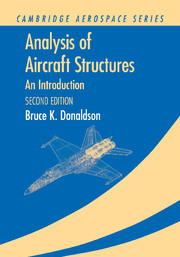Book contents
- Frontmatter
- Contents
- Introduction to the Second Edition
- Introduction to the First Edition
- List of Repeated Engineering Symbols
- Acknowledgments
- Part I The Fundamentals of Structural Analysis
- Part II **Introduction to the Theory of Elasticity**
- Part III Engineering Theory for Straight, Long Beams
- Part IV Work and Energy Principles
- Part V Energy-Based Numerical Solutions
- 16 **Precursor Numerical Analyses**
- 17 Introduction to the Finite Element Method
- 18 Finite Element Truss Problems
- 19 Basic Aspects of Multidimensional Finite Elements
- 20 The Unit Load Method for Determinate Structures
- 21 The Unit Load Method for Indeterminate Structures
- Parts IV and V Review Questions
- Part VI Thin Plate Theory and Structural Stability
- Appendix A Additional Topics
- Appendix B Selected Answers to Exercises
- References
- Index
16 - **Precursor Numerical Analyses**
from Part V - Energy-Based Numerical Solutions
Published online by Cambridge University Press: 05 June 2012
- Frontmatter
- Contents
- Introduction to the Second Edition
- Introduction to the First Edition
- List of Repeated Engineering Symbols
- Acknowledgments
- Part I The Fundamentals of Structural Analysis
- Part II **Introduction to the Theory of Elasticity**
- Part III Engineering Theory for Straight, Long Beams
- Part IV Work and Energy Principles
- Part V Energy-Based Numerical Solutions
- 16 **Precursor Numerical Analyses**
- 17 Introduction to the Finite Element Method
- 18 Finite Element Truss Problems
- 19 Basic Aspects of Multidimensional Finite Elements
- 20 The Unit Load Method for Determinate Structures
- 21 The Unit Load Method for Indeterminate Structures
- Parts IV and V Review Questions
- Part VI Thin Plate Theory and Structural Stability
- Appendix A Additional Topics
- Appendix B Selected Answers to Exercises
- References
- Index
Summary
Introduction
Routine analyses of structures whose mathematical models contain more than two or three structural elements (e.g., beams, plates, springs) are accomplished today using one or another of the commercially available, large or small capacity, standard structural analysis digital computer software packages. The larger commercially available structural analysis programs have become so inclusive, that few types of analyses are beyond their reach. In addition to producing what is called a numerical analysis of the structure's mathematical model, such software packages, perhaps in combination with auxiliary programs, are also commonly used in creating a structure's mathematical model, and in simplifying the interpretation of the analysis results. The basis for the large majority, if not all, of these general use software packages is a numerical analysis technique called the finite element method, which is introduced in Chapter 17.
The essence of any numerical analysis is the replacement of a collection of partial or ordinary differential equations (or sometimes integral equations) by a much larger set of simultaneous, algebraic equations. The set of algebraic equations involve an equal number of algebraic variables that, in one sense or another, are used to approximate the continuous, unknown functions of the differential equations being replaced by the algebaric equations. In almost every case, the differential equations are those obtained from strength of materials. If the differential equations are nonlinear, so too are the algebraic equations.
- Type
- Chapter
- Information
- Analysis of Aircraft StructuresAn Introduction, pp. 523 - 544Publisher: Cambridge University PressPrint publication year: 2008



